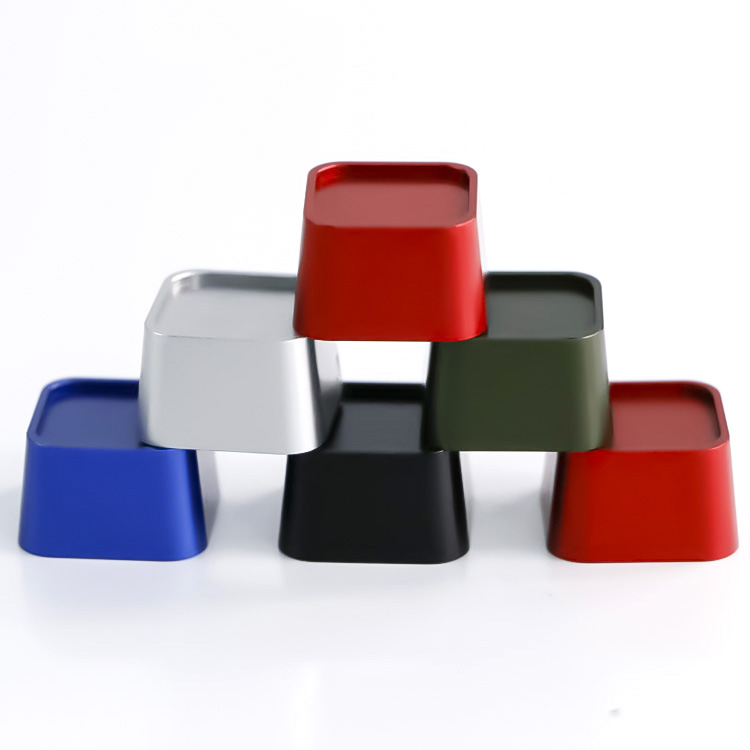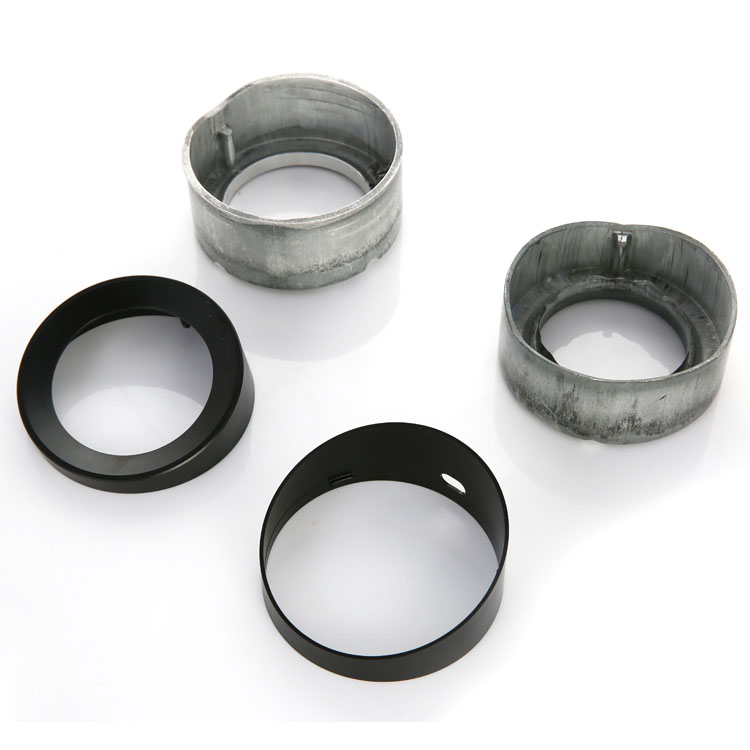Cast Aluminum vs Forged Aluminium: A Guide to the Differences
In the field of CNC machining services, aluminum has become an indispensable material for many industries due to its lightweight, corrosion resistance and easy machining. Cast aluminum and forged aluminum, as the main forms of aluminum machining, each has unique process characteristics and application advantages. Understanding the difference between the two will not only help you make wise decisions when choosing machining, but also ensure the efficiency and accuracy of CNC machining services. This article will explore the difference between cast aluminum and forged aluminum in depth.
What is Cast Aluminum?
Cast aluminum is a process in which pure aluminum or aluminum alloy ingots are prepared according to standard composition ratios, artificially heated to turn them into liquid or molten aluminum alloy, and then poured into a mold cavity through a professional mold or corresponding process, and then cooled to form aluminum parts of the required shape.

Properties of Cast Aluminum.
Good fluidity: Aluminum alloy has good fluidity when in a liquid state and can fill complex casting cavities to produce castings with complex shapes.
Shrinkage: Aluminum alloy will shrink to a certain extent during the solidification process, but a reasonable pouring process and riser design can reduce the impact of shrinkage on casting quality. The shrinkage of aluminum alloy has a decisive influence on the quality of castings, which affects the shrinkage size of castings, the generation of stress, the formation of cracks and the change of size.
Air tightness: Cast aluminum alloy has high air tightness and is suitable for occasions that require sealing performance.
Advantages of Cast Aluminum
Low cost: Aluminum casting production is suitable for mass production, and the mold cost can be amortized over mass production, making the cost of a single aluminum casting relatively low.
Good corrosion resistance: Aluminum itself has good corrosion resistance. Through appropriate surface treatment (such as anodizing, electrophoretic coating, etc.), the corrosion resistance and aesthetics of aluminum castings can be further improved.
Lightweight: Aluminum has a low density, so cast aluminum products are relatively light, which helps to reduce overall weight and improve energy efficiency, which is especially important in the fields of automobiles, aerospace, etc.
What is Forged Aluminum?
Forging aluminum is a process that heats an aluminum block to a plastic state and then deforms it into the desired shape through pressure or impact. This process not only increases the density and strength of the aluminum, but also improves its internal structure. In CNC machining services, forged aluminum parts are often the preferred material for parts with high precision and high-performance requirements.

Properties of Forged Aluminum.
Forged aluminum has remarkable performance characteristics, including high strength, high toughness, excellent fatigue resistance and strong impact resistance. These improvements are mainly due to the denser and more continuous fiber structure formed inside the material during the forging process.
Different series of wrought aluminum alloys show their unique performance advantages by adjusting the content of alloying elements. The following is an overview of the performance of several major series of wrought aluminum alloys:
1000 Series: Mainly composed of 99.00% to 99.99% pure aluminum, although its tensile strength and yield strength are relatively low, but it has good ductility and machinability, suitable for applications where high strength requirements are not high.
2000 Series: Contains 2.2% to 6.8% copper, which significantly improves the strength and hardness of the alloy, making it an ideal choice for applications requiring high strength and good heat resistance.
3000 Series: 0.3% to 1.5% manganese is added to improve the strength and corrosion resistance of the alloy. It is suitable for applications requiring a certain strength and corrosion resistance.
4000 Series: Contains 3.6% to 13.5% silicon, as well as appropriate amounts of copper and magnesium. It has medium to high strength and good wear resistance, and is suitable for situations that need to withstand wear and impact.
5000 Series: With 0.5% to 5.5% magnesium as the main alloying element, it has good corrosion resistance and weldability while maintaining a certain strength. It is the preferred material for many applications.
6000 Series: Combines 0.2% to 1.8% silicon and 0.35% to 1.5% magnesium, exhibits good processing properties and moderate strength, and is suitable for applications requiring certain strength and good machining properties.
Advantages of Forged Aluminum.
As an aluminum alloy product processed by the forging process, forged aluminum has many significant advantages, which make it widely used in many fields. The following are the main advantages of forged aluminum:
High strength and toughness: Aluminum is subjected to strong plastic deformation, which makes its internal grains refined and the structure denser, thus significantly improving the strength and toughness of the material. This high strength and toughness enables forged aluminum to withstand greater loads and impacts, and is suitable for occasions with high requirements for material performance.
Excellent impact resistance: The high toughness and dense organizational structure of forged aluminum make it have excellent impact resistance. When subjected to impact loads, forged aluminum can absorb more energy and reduce the damage to the material itself and the connected parts.
Good processing performance: Forged aluminum acquires good plasticity and ductility during the forging process, making it easy to carry out subsequent machining and forming processes.
Wide range of applications: Due to its high strength, high toughness, good impact resistance and excellent processing performance, forged aluminum is widely used in aerospace, automobile manufacturing, transportation, structural engineering and other fields. For example, in the aerospace field, forged aluminum is used to manufacture key components such as engine parts and fuselage structural parts; in the automobile manufacturing field, forged aluminum is used to manufacture components such as wheels and suspension systems.
The Difference Between Cast Aluminum and Forged Aluminum
There are significant differences between cast aluminum and forged aluminum in many aspects, which are mainly reflected in the forming method, material properties, performance and scope of application.
-
Molding Method.
Cast aluminum: Aluminum castings are made by melting the raw materials in a smelting furnace, pouring them into a mold, and then forming them after cooling. This molding method is relatively simple, suitable for mass production, and can produce castings with complex shapes.
Forged aluminum: Forged aluminum uses a forging press to place aluminum alloy materials at a corresponding temperature and change the shape and size of the material by applying force.
-
Material Properties.
Cast aluminum: Since cast aluminum parts are directly cast, their grain size is relatively coarse and the metal density is low.
Forged aluminum: After high-temperature forging, the grain size of wrought aluminum becomes fine and uniform, and the density is significantly improved.
-
Performance.
Cast aluminum: Cast aluminum parts have average performance in terms of strength, hardness and wear resistance, but their cost is low and they are suitable for occasions where performance requirements are not high. In addition, cast aluminum parts also have good casting performance and molding flexibility.
Forged aluminum: Forged aluminum performs well in strength, toughness, fatigue resistance and impact resistance. Its high strength and toughness enable forged aluminum to withstand greater loads and impacts, making it suitable for applications that require higher material performance.
-
Scope of Application.
Cast aluminum: Due to its low cost and flexible molding, cast aluminum is suitable for mass production of parts with simpler shapes, such as automobile engine blocks, wheels, etc.
Forged aluminum: Due to its excellent performance, forged aluminum is widely used in situations where high material performance is required, such as key components such as turbine blades and aircraft fuselages in the aerospace field, as well as components such as engines and chassis in the automotive industry.
Cast Aluminum vs Forged Aluminum: How to Choose the Right One
When choosing between cast and forged aluminum, there are many dimensions to consider to ensure the material selected will meet specific application requirements. Here are some key considerations:
Strength and Toughness:
If the application has high requirements for the strength and toughness of the material, such as key components in the fields of aerospace, automobile manufacturing, etc., forged aluminum is usually a better choice. After forging, the grain of wrought aluminum is refined and the density is increased, thereby improving strength and toughness.
For some occasions where strength requirements are not high, such as the casing or decorative parts of some civilian products, cast aluminum may be an economical and practical choice.
CorrosionResistance:
Aluminum and its alloy surfaces easily form a dense oxide film, so both cast and wrought aluminum have a certain degree of corrosion resistance. However, in some extremely corrosive environments, it may be necessary to select aluminum with a specific alloy composition or perform additional surface treatment to improve corrosion resistance.
Machining Cost:
The machining cost of cast aluminum parts is relatively low because they can usually be directly formed by casting, reducing the need for subsequent processing. Forged aluminum parts require multiple steps such as forging, heat treatment, and machining, and the processing cost is higher.
Machining Performance:
Cast aluminum and forged aluminum also differ in their machining properties. Forged aluminum generally has better machining properties and can be more easily machined by subsequent machining such as cutting and drilling. Cast aluminum, on the other hand, may require additional processing in some cases to achieve the required accuracy and surface quality.
In Conclusion
Cast aluminum and forged aluminum each have their own characteristics and advantages in the field of CNC machining. Cast aluminum has low cost and excellent casting performance, which is suitable for mass production of parts with complex shapes; while forged aluminum is unique in the field of high-performance requirements due to its high strength, high toughness and precise dimensional control. When choosing, it is necessary to comprehensively consider the application scenario, performance requirements and economic costs to determine the best machining solution.
Choose VMT AS Your Partner for Your Forged Aluminum or Cast Aluminum Projects.
Whether it is forged aluminum or cast aluminum CNC machining needs, VMT provides customized consulting and services with a professional attitude to ensure excellent part accuracy and performance. We have advanced CNC machining equipment and an experienced technical team to provide customized aluminum parts machining solutions, including casting, forging and prototype machining, to meet the needs of different customers. Choose VMT to get a one-stop service to help your project succeed.
Frequently Asked Questions About Cast Aluminum and Forged Aluminium
Which Is More Expensive, Cast Aluminum Or Forged Aluminum?
Generally speaking, the price of forged aluminum is higher than that of cast aluminum. This is mainly because the production process of forged aluminum is more complicated, requiring multiple links such as forging, heat treatment, and machining, and has high technical requirements for equipment and workers, so the production cost is higher. In contrast, the production process of cast aluminum is relatively simple, and aluminum liquid can be directly cast into the required shape, and the material cost and processing cost are relatively low.
What Is The Difference Between Aluminum Alloy And Cast Aluminum?
The main difference between aluminum alloy and cast aluminum is that aluminum alloy is a large category, including various types such as deformed aluminum alloy and cast aluminum alloy. The former is manufactured by plastic deformation, while the latter is mainly used for casting. Cast aluminum specifically refers to aluminum products produced by casting process, which is low-cost and flexible in production, but the performance may not be as good as deformed aluminum alloy. Aluminum alloy as a whole, due to its diverse composition and process, shows the characteristics of high strength, corrosion resistance and good formability, and is widely used in many industries.
Which Has More Defects, Castings Or Forgings?
Castings and forgings have their own characteristics in terms of defects, and it is difficult to simply compare which one has more defects. Common defects in castings include holes, cracks, cold shuts, and slag inclusions, which are caused by their uneven structure, rough surface, and complex shape; while forgings may have shrinkage, cracks, folds, and other defects due to the forging process, raw material quality, and heat treatment. Although forging can improve density, it may also introduce new defects. Both require strict process control to reduce defects.



